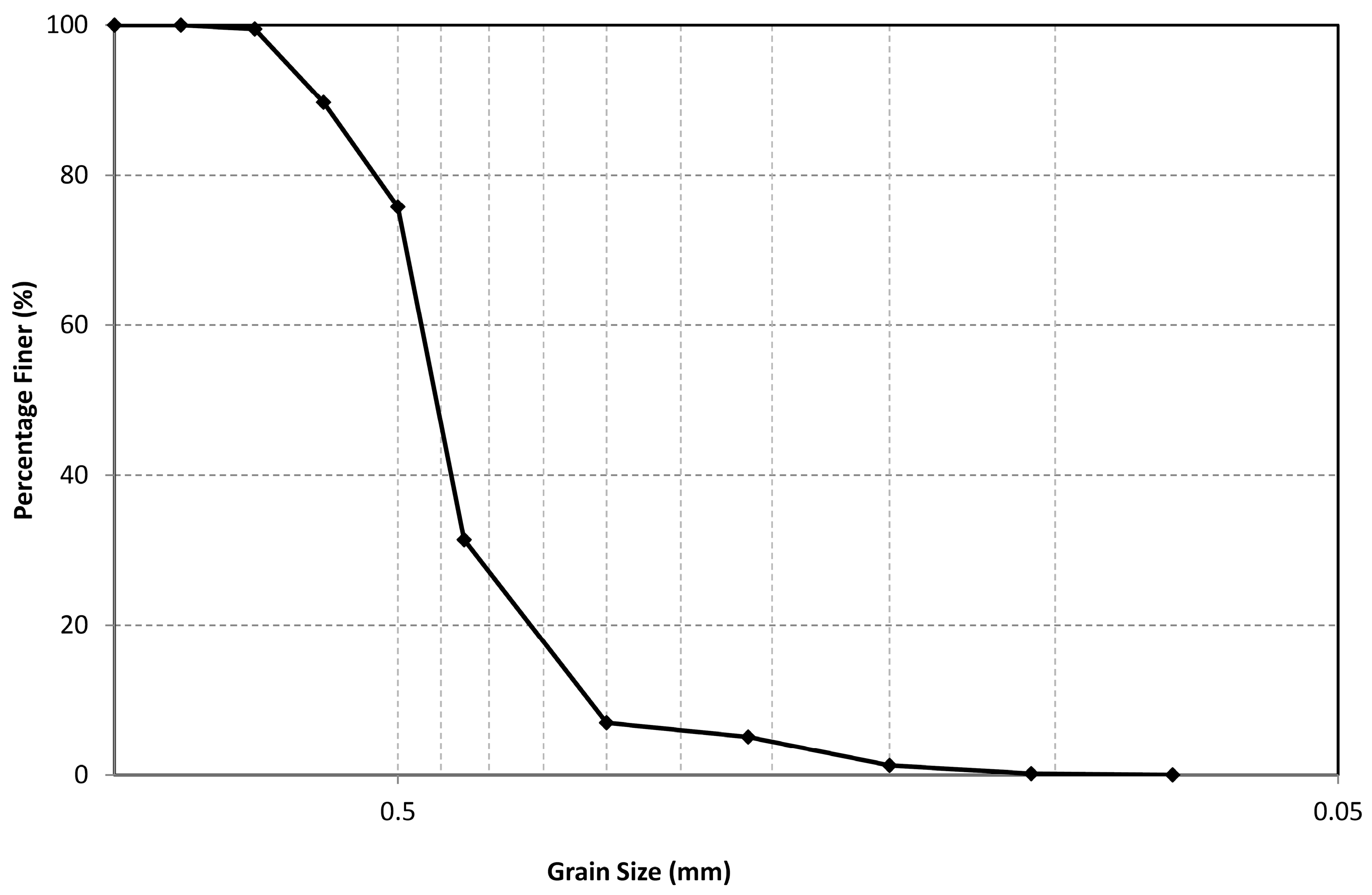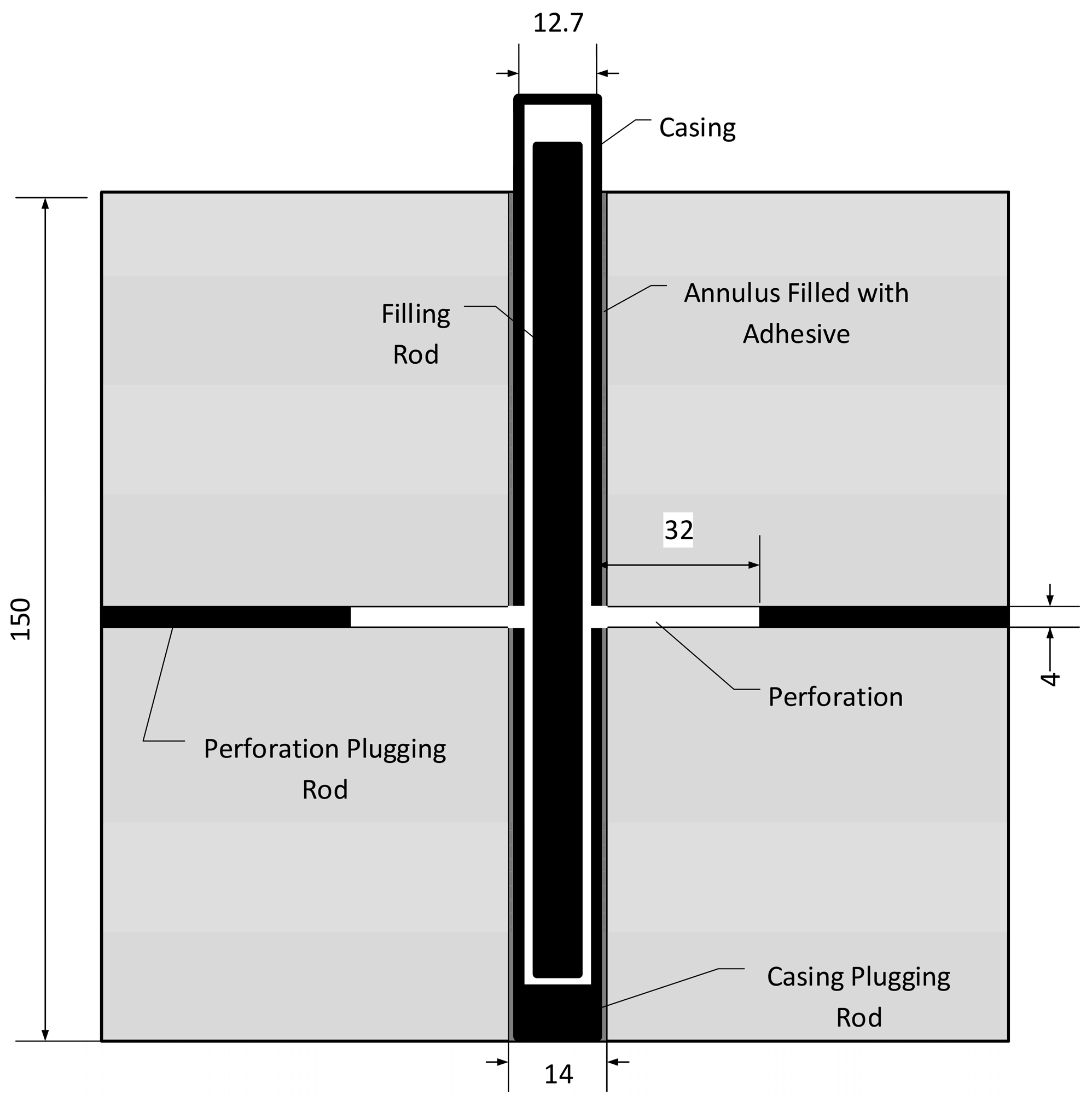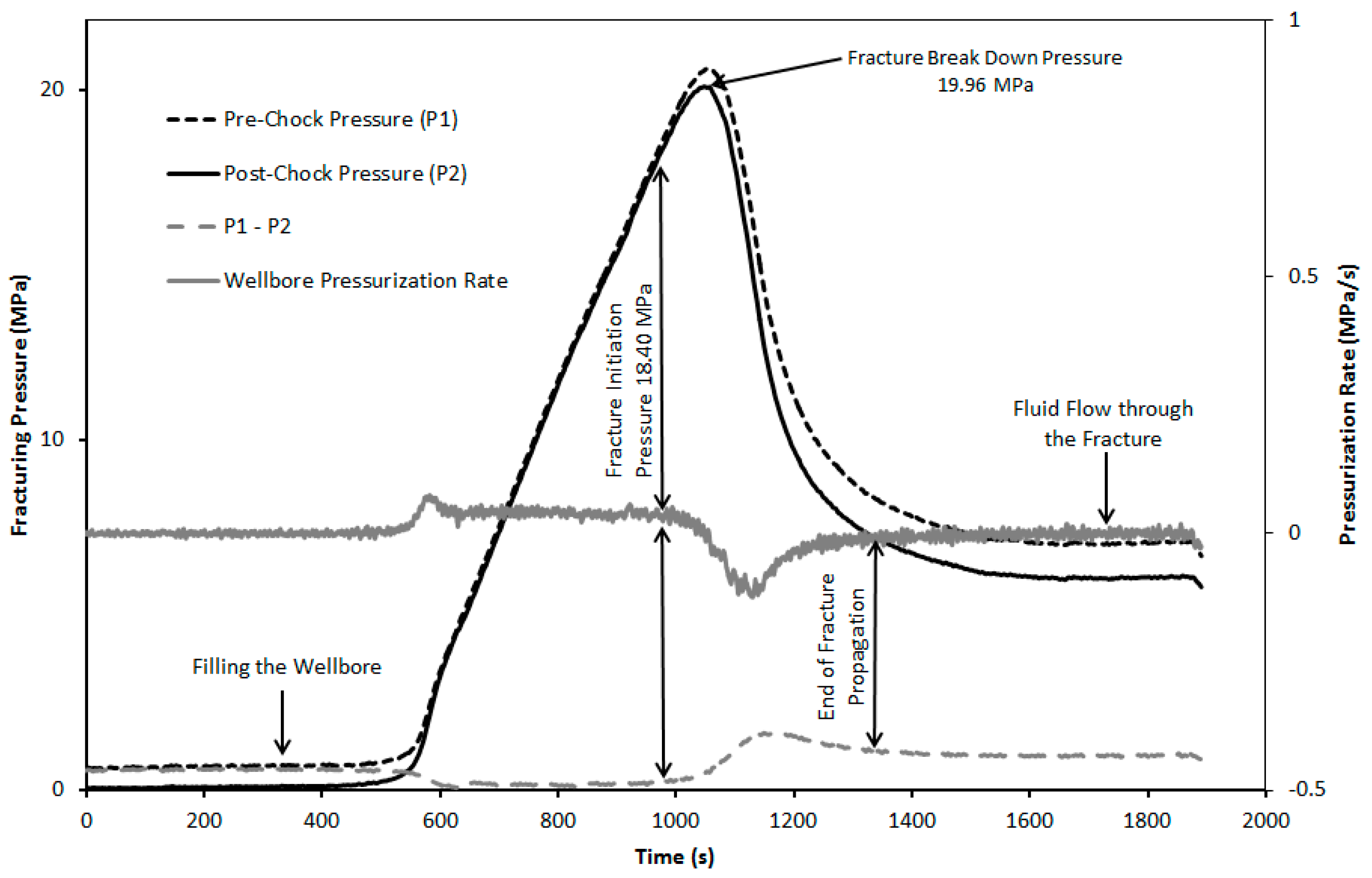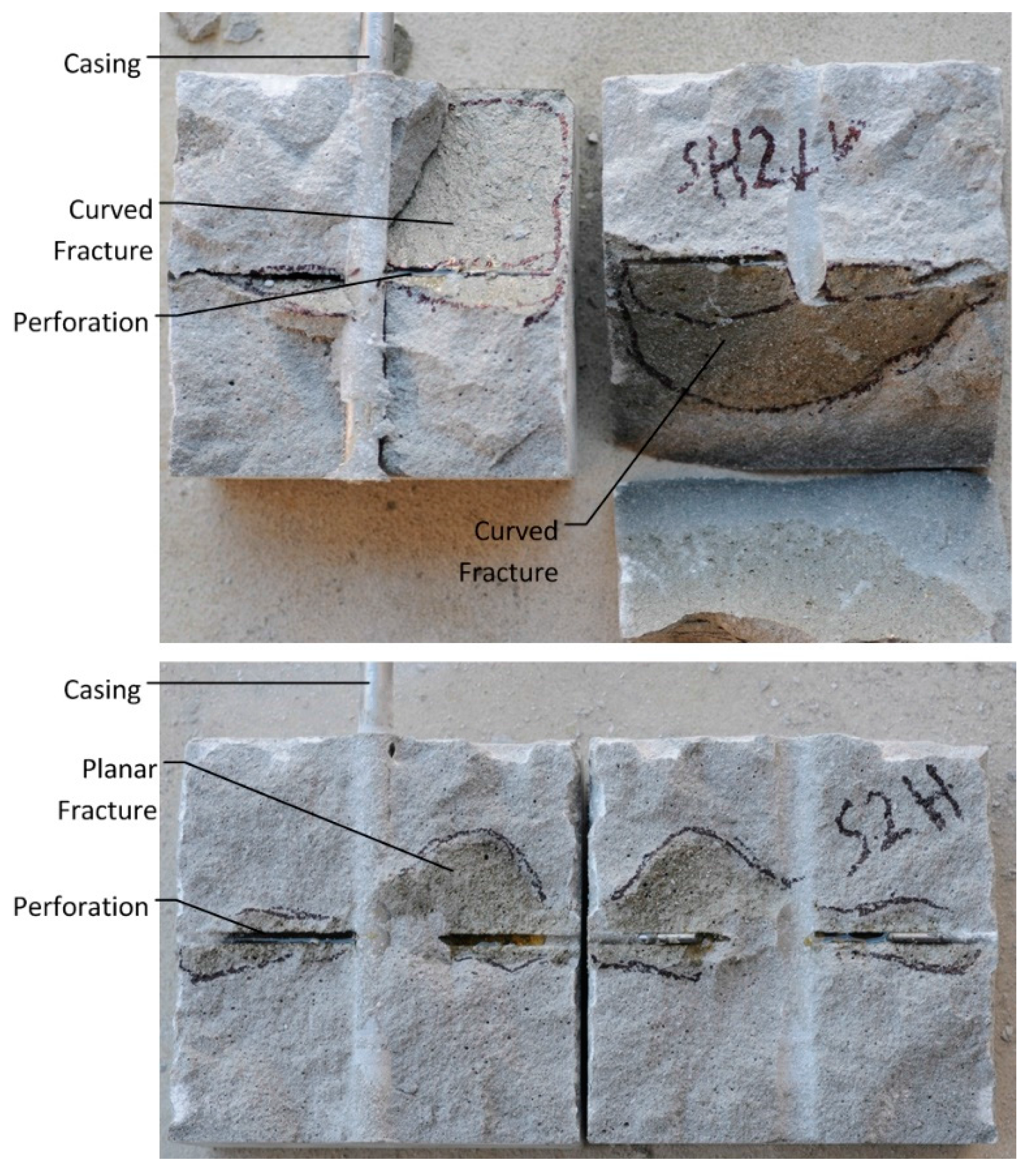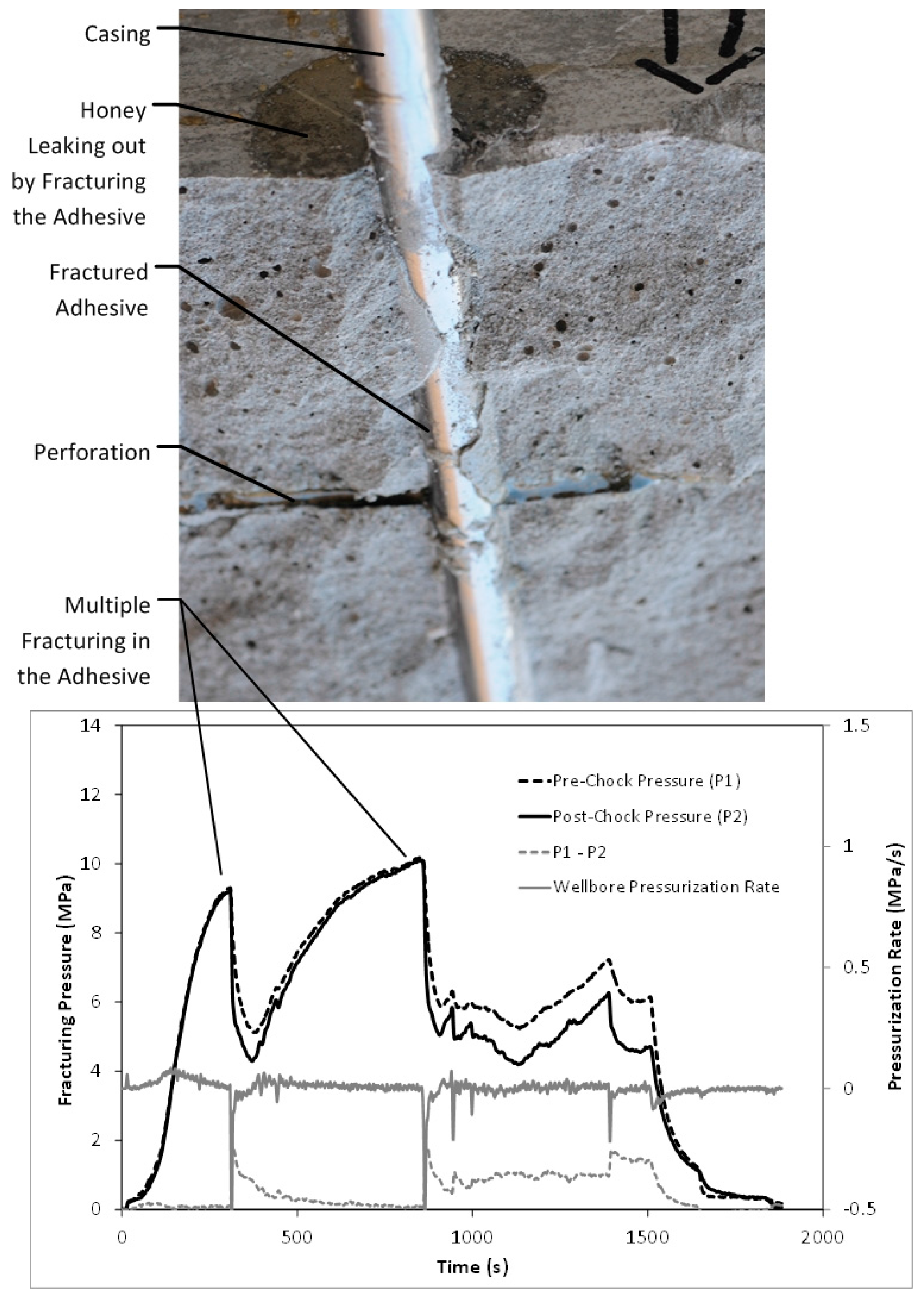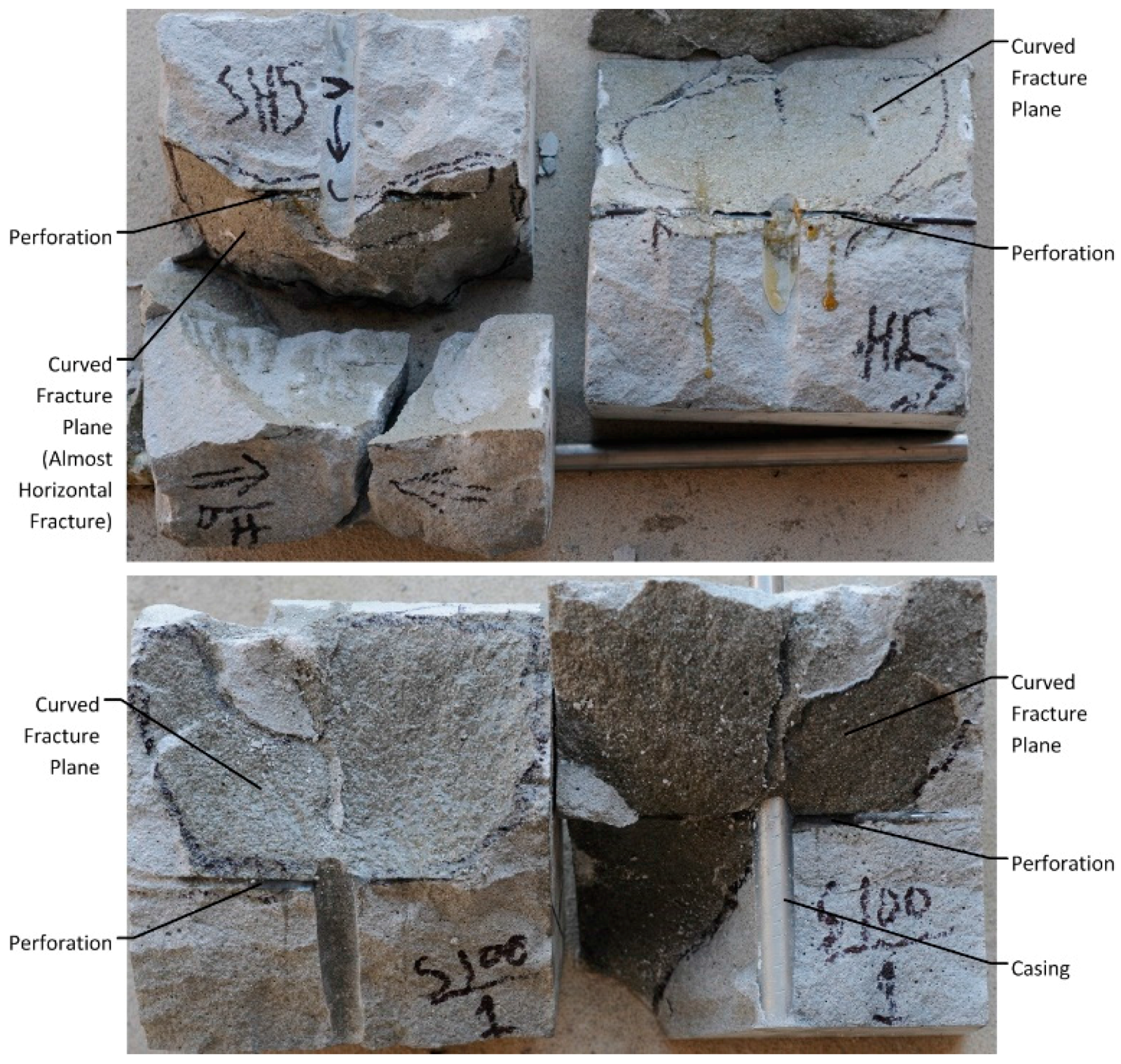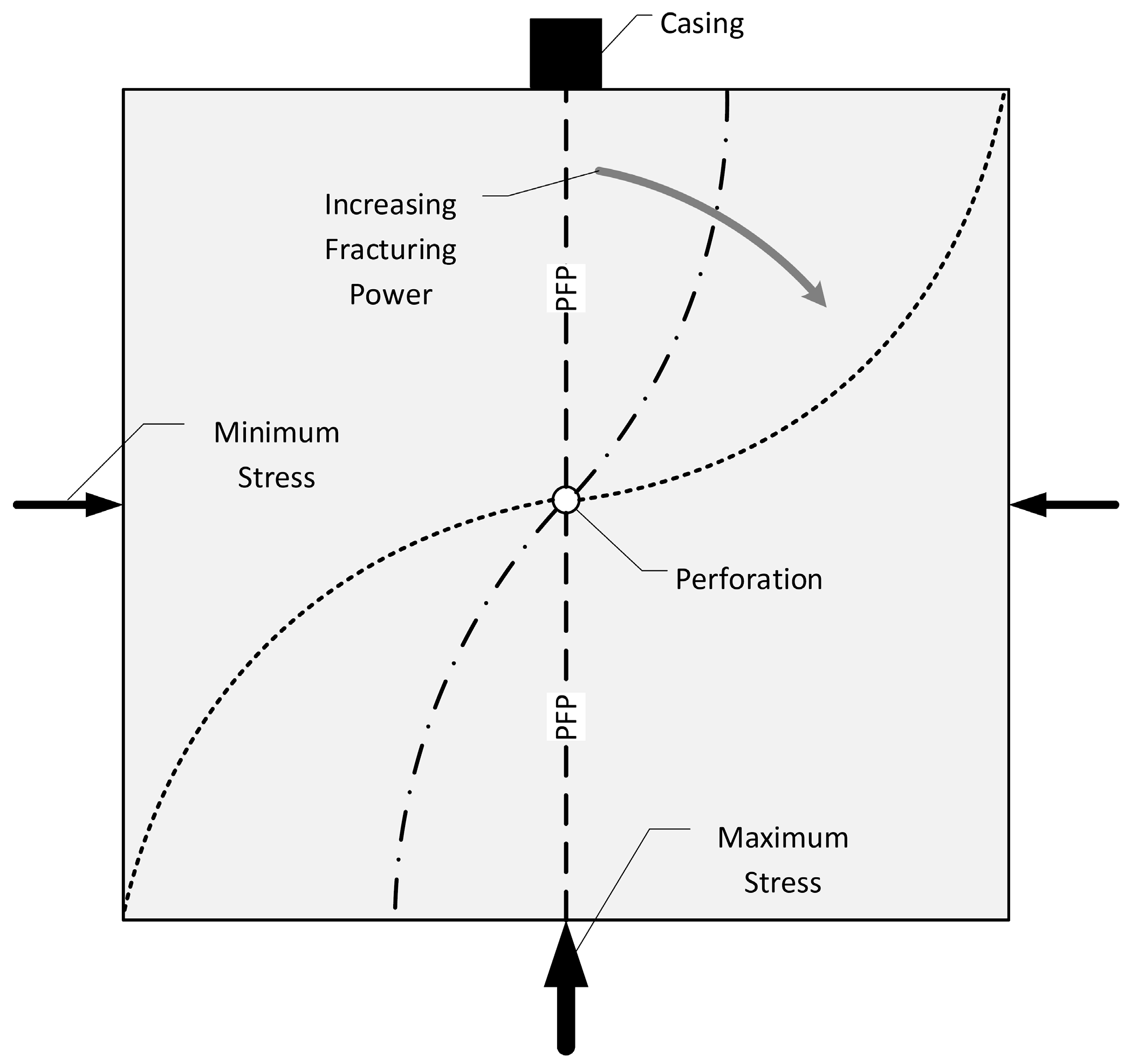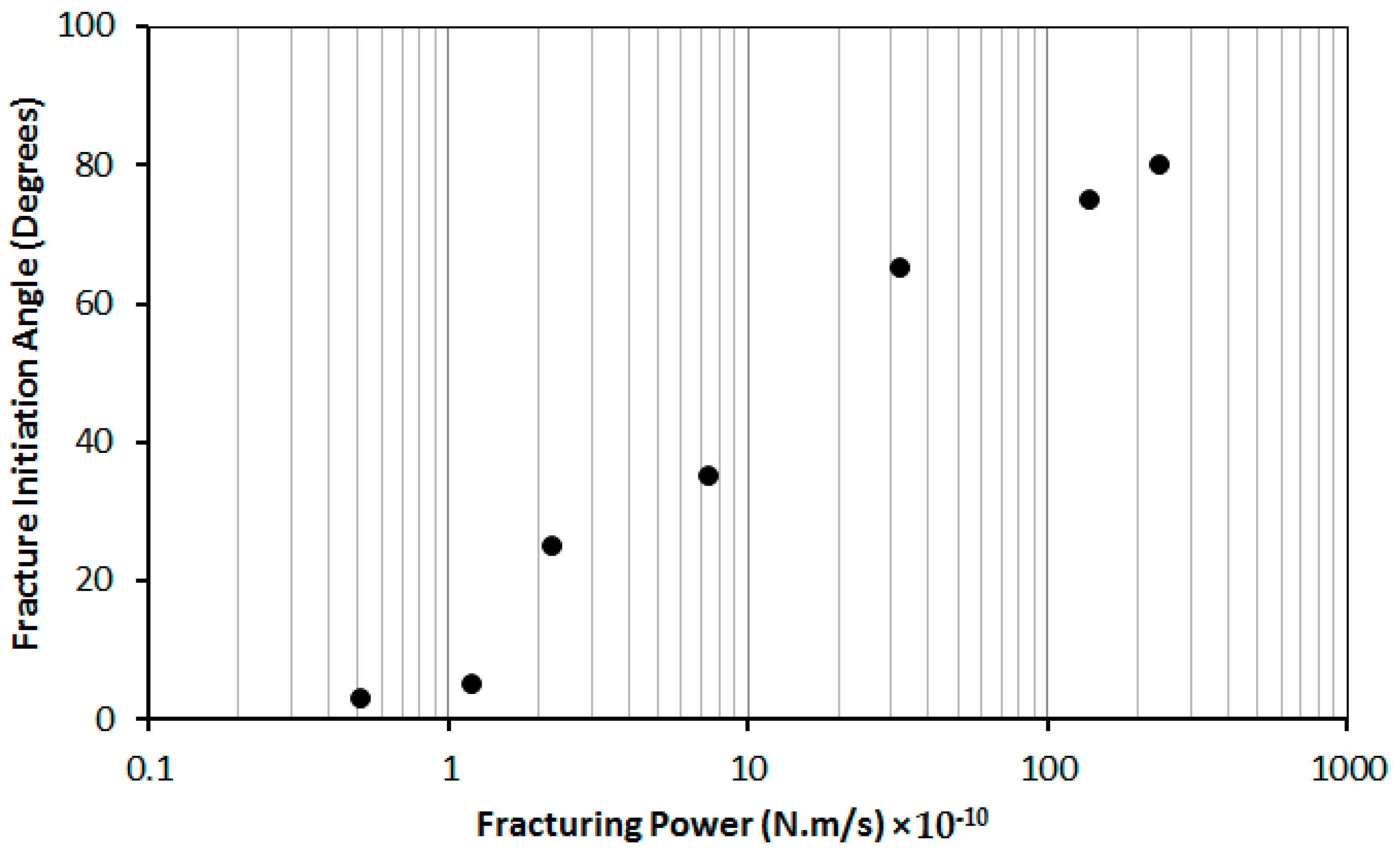According to the scaling analysis presented in
Section 4, to conduct a scaled hydraulic fracturing experiment, the use of a very high fracturing fluid viscosity is necessary. This is basically to properly simulate the real physical phenomena taking place over the course of a field hydraulic fracturing process to laboratory experiments [
24]. The other important parameter that is involved in the fracturing process is the injection flow rate. Typically, in laboratory experiments, when a very high viscous fluid is used, the injection flow rate should be much lower than the field operation injection rates [
25]. In this study, three different fracturing fluids were used, and in each test a particular injection flow rate ranging from 0.05 to 5 cc/min was considered to investigate the impacts of these two important parameters on fracturing pressure, propagation and near wellbore geometry.
Because every test had a specific flow rate and viscosity, the product of flow rate and viscosity (Q × μ) is considered in order to ease the tests’ results comparison and simplify the analysis. Considering the unit of flow rate (m3/s) and the unit of viscosity (N.s/m2), it is realized that the unit of the product of flow rate and viscosity will be N.m. This means that the product is representing the energy which is supplied for hydraulic fracturing. Such fracturing energy concept is later used to better interpret the tests’ results.
5.3.1. Fracturing Pressures
Fracture initiation and break down pressures are the two most critical parameters of a fracturing operation, especially in cased perforated wellbore. Analyzing the fracture initiation and break down pressures presented in
Table 4 along with their corresponding fracturing fluid viscosities and flow rates would reveal that as the product of flow rate and viscosity increases, generally higher pressures are experienced.
For instance, test SL-3, was performed using silicone oil as the fracturing fluid with a viscosity of 97,700 cp, and the injection flow rate was 0.05 cc/min. This sample exhibited multiple fracturing and the first fracture was initiated at a pressure of 7.98 MPa and its break down pressure was 8.16 MPa. This first fracture did not propagate much and the wellbore pressure increased again and the second fracture was initiated at a wellbore pressure of 14.37 MPa and at this time the break down pressure was recorded to be 14.65 MP. Comparing this test with test SH-1, in which silicone oil viscosity was 586,800 cp and the injection flow rate was 1 cc/min, it is observed that the latter test demonstrated a much larger fracturing pressures. In which the initiation and break down pressures were 32.75 MPa and 35.65 MPa, respectively.
Similarly, comparing tests SH-1 and SH-2 would lead to the same result. These two tests were both conducted using silicone oil with a viscosity of 586,800 cp; however, the injection flow rate in test SH-2 was one tenth of the flow rate in test SH-1. Consequently, in test SH-2, the fracture was initiated at a pressure of 28.27 MPa, while it was 32.75 MPa in test SH-1. The break down pressures also showed a difference of almost 3 MPa between the two tests. These comparisons highlight that a larger product of injection flow rate and viscosity would lead to higher fracturing pressures.
This is mainly because as a viscous fracturing fluid is injected at a higher flow rate, more energy is supplied to the wellbore. Consequently, the wellbore pressurization rate increases. This makes the fracturing process more dynamic, and as a result larger fracture initiation and break down pressures would be required to create a fracture. Physically, when a rock or concrete sample is loaded dynamically, it would exhibit larger strength parameters [
31]. The same concept appears to be valid for a hydraulic fracturing test, further research is required to investigate this in more details.
5.3.2. Fracture Geometry
The geometry of the hydraulic fracture (specifically near the wellbore) plays an important role during the fracturing operation. A more planar fracture plane would result in a wider fracture with lesser frictional pressure loss. Additionally, the chance of proppant bridging over a planar fracture plane is lower. Moreover, a planar fracture plane is favorable for hydrocarbon production, because oil and gas could flow through such fracture with less pressure reduction.
A description of fracture geometries for every sample is presented in
Table 5. Analyzing these fracture geometries along with the experimental parameters (see
Table 4) would demonstrate how the injection flow rate and fluid viscosity may influence the near wellbore fracture geometry. Generally, because every sample had two perforations parallel to the direction of intermediate stress (maximum horizontal stress), it was expected that a two-wing fracture plane would be initiated from the top and bottom side of each perforation. And then it would propagate vertically, perpendicular to the direction of minimum stress. However, most of the fractures were initiated in an angle with respect to the vertical plane (herein preferred fracture plane), and propagated in a curved path away from the wellbore and eventually, the tip of the fractures grew towards the vertical plane.
Figure 6 shows the fracture geometries of the samples fractured in tests H-2 and H-3. As it is seen in this figure, in test H-2 almost a vertical fracture (along PFP) was developed. However, test H-3 resulted in a curved fracture plane, where the fracture was initiated from the perforations in an angle with respect to PFP, but each wing of fracture propagated in a curved path towards the PFP. As it is described in
Table 5, tests H-4, SL-1, SL-3, and SH-1 also experienced curved fracture planes. However, the angles (with respect to PFP) at which the fractures were initiated from the perforations, as well as the curvature of the fracture planes were not the same in all these tests.
For instance, as it is shown in
Figure 8, in test H-4 two-wing fractures were initiated from each perforation. However, the bottom fracture was initiated at a larger initiation angle than the top fracture. Moreover, the bottom fracture propagated almost in the horizontal plane, which is perpendicular to the vertical stress, while the top wing grew in a curved path towards the PFP. Test SL-1 also resulted in two-wing fractures; however, the fracture initiation angle for this test is less than that of test H-4. Additionally, the top and bottom fractures in test SL-1 experienced less curvature in comparison to the fractures in test H-4.
In order to recognize the relationship between fracture initiation angle and propagation geometry with the injection flow rate and viscosity, it is helpful to recall the product of these two parameters (
Q ×
μ). The product of injection flow rate and viscosity is calculated for each test and presented in
Table 6. Although by increasing the product value, higher initiation and break down pressures were recorded, it appears that some of the tests have the same product values, while their fractures’ geometries are different. For instance, tests H-4 and SL-1 have almost the same product value (see
Table 6); however, their fracture geometries are not the same.
To clarify this controversy, it is worthwhile to mention that the product of injection flow rate and viscosity represents the amount of energy applied to pressurize the wellbores and create the fractures. However, because every test had a particular injection rate and fluid viscosity, the wellbore pressurization time was not the same for all tests. For example, sample H-4 was pressurized with a flow rate of 5 cc/min using honey with a viscosity of 20 Pa.s, while sample SL-1 was tested using silicone oil with a viscosity of 97.7 Pa.s and a flow rate of 1 cc/min. Hence, sample H-4 was pressurized much faster than sample SL-1, since a much less viscous fluid was injected into its wellbore at a higher flow rate. This is while both samples had almost the same level of fracturing energy (
Q ×
μ), but sample H-4 had received this energy at a faster rate. Therefore, it would be significantly helpful to divide the fracturing energy by the time interval at which this energy was supplied to each sample. Energy divided by time would introduce a new parameter which is considered to be the fracturing power as given below:
The time interval t is considered to be the wellbore pressurization time in each test. This time interval starts with the moment when the wellbore begins to pressurize and ends when the fracture breaks down.
Table 6 summarizes the fracturing energy, pressurization time, and fracturing power as well as the characteristics of fracture geometry for each test, excluding test H-1 in which no fracture was developed in the sample. Each fracture geometry is characterized by an initiation angle, which is the angle at which the fracture was initiated from the perforation with respect to the PFP. Additionally, the fracture propagation plane is also generally characterized as either planar or curved.
Comparing the fracturing powers of tests H-4 and SL-1 indicates why the fracture geometry in test H-4 had a larger initiation angle and a more curved fracture plane (see
Figure 8), although they have almost equal fracturing energy of about 16 × 10
−7 N.m. The same result is concluded when comparing the fracturing power and geometries in the other tests. For example, test SH-1 experienced a fracturing power of almost 140 × 10
−10 N.m/s, and as a result a curved fracture with an initiation angle of 75 degrees was created in this test.
In contrary, tests H-2, SL-2 and SH-2 had very low fracturing powers and consequently, an almost planar fracture was initiated from their perforations and propagated in the vertical direction, along PFP. Thus, generally, it is concluded that the fracturing energy could not be directly related to the fracture initiation and propagation geometry. Nevertheless, the fracturing power could be associated with the fracture geometry very well.
Basically, as it is demonstrated in
Figure 9, by increasing the fracturing power supplied to the sample, the wellbore pressurization rate increases. Consequently, the fracture initiation angle increases. This means that at higher fracturing power, fractures could be initiated from the perforations in a direction which is perpendicular to higher stress components (herein vertical stress). Accordingly, the fracture propagation would have a longer curved path so that it could get aligned with the PFP (the plane to which the minimum stress is perpendicular).
A graph of fracture initiation angle versus fracturing power shows that there is a linear relationship between these two parameters on a semi-log plot (
Figure 10). Such relationship could introduce the following general equation:
where
λ is the initiation angle,
Pf is the fracturing power, and
a and
b are the constants of the equation, that may depend on sample’s properties and the applied principal stresses. Further experiments and analysis are required to justify this equation and to include the effects of fracturing power on the fracture propagation curvature, because the curvature of the fracture appears to be closely related to its initiation angle.
It should be noted that test SL-3 had the lowest fracturing power of 0.06 × 10
−10 N.m/s; however, in this test a single fracture was not developed. The injection flow rate was as low as 0.05 cc/min in this test. Such low flow rate, which was applied to a high viscous fracturing fluid (97.7 Pa.s), resulted in very long pressurization time (14,000 s). Consequently, a very low fracturing power was supplied to the sample, which led to multiple fracturing over the course of wellbore pressurization. This is in good agreement with the results obtained in the experimental study conducted by Van de Ketterij [
15]; while they only considered the product of injection flow rate and viscosity and did not indicate the influence of fracturing power. Therefore, test SL-3 is the only test that appears not following the relationship between the fracturing power and the fracture propagation geometry, and this is due to the very low power that led to multiple fracturing.
5.3.3. Casing Effect
As it was mentioned earlier, in most of the tested samples, the fractures were initiated from the perforations in an angle with respect to a vertical plane (PFP). Then the tip of the fracture turned towards the PFP in some distance away from the wellbore wall. The fracturing power is now believed to be the main reason for the curvature of the fractures. However, the existence of the casing also played an important role. The steel casing has different elastic moduli with respect to the synthetic sample. Generally, the elastic Young’s modulus of the casing is larger than that of the sample.
Therefore, if one compares a pressurized open wellbore with a pressurized cased wellbore, assuming that both of them are at the same pressure, the open wellbore would experience larger radial stress on the wellbore wall. This is due to the fact that when the casing is pressurized, the whole fluid pressure would not be transferred to the surrounding wellbore’s material because casing would have less radial displacement in comparison to the open wellbore [
20]. As a result, less radial stress would be transferred to the wellbore wall. Lower radial stress would accordingly lead to higher tangential stress, so the casing can affect the wellbore and accordingly the perforation stress distribution. Consequently, the fracture initiation and break down pressures would be affected.
Authors have previously conducted some fracturing experiments on the same synthetic samples [
12]. However, in the previous study, there was no casing and the perforations were drilled in the openhole. It is noteworthy that the diameter of the perforations in the aforementioned study was 2 mm larger than the current study. However, based on the elastic stress distribution equation for the analysis of the stress profile around a circular cavity [
31], the radius of the perforation does not have an effect on its stress distribution. Therefore, the results of the two experimental studies could be compared with each other.
A comparison between the fracture initiation and break down pressures of the planar fracture in this study with those of similar fracture geometries in the previous study reveals that the existence of the casing has significantly increased the fracturing pressures. As an example, in test SL-2, where a planar vertical fracture was propagated, the fracture initiation and break down pressure were 17.44 MPa and 18.19 MPa respectively. Similar planar vertical fracture geometry in the previous study (tests 2–3 in [
12]) was developed at an initiation pressure of 6.89 MPa and the corresponding break down pressure was 7.62 MPa. This comparison clearly illustrates the impact of the casing on wellbore and perforation stress distributions, and consequently the increase in the fracturing pressures.
